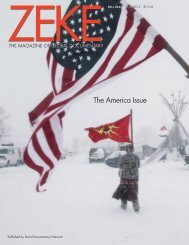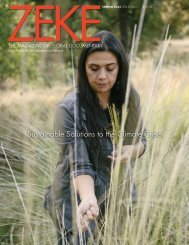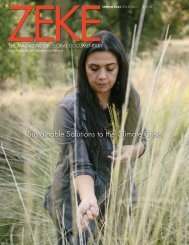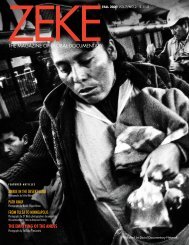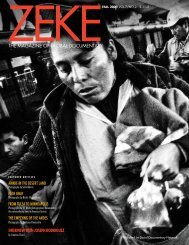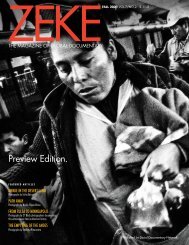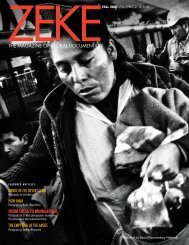Preview: Spring 2023 ZEKE Magazine
You also want an ePaper? Increase the reach of your titles
YUMPU automatically turns print PDFs into web optimized ePapers that Google loves.
2023 VOL.9/NO.1 $15 US
ZEKESPRING
THE MAGAZINE OF GLOBAL DOCUMENTARY
Published by Social Documentary Network
Preview Edition
ZEKE SPRING 2023/ 1
ZEKE AWARD FOR SYSTEMIC CHANGE
FIRST-PLACE WINNER
Piatsaw
Photos by Nicola Ókin Frioli
Ecuador
Piatsaw was the first man, and God, of
the Sapara mythology who prophesied
the end of the culture of his people.
This documentary tells the story of the
resistance that the Indigenous people
of the Ecuadorian Amazon have
waged against extractive companies
that threaten their territories through
continuous concessions and contamination
caused by Texaco during its
presence in the country. In 1964, Texaco
(now Chevron), arrived in Ecuador with a
concession of 1.5 million hectares in the
provinces of Sucumbíos and Orellana. At
that time, they were extracting oil from
450,000 hectares. The oil giant admitted
in court to having dumped 19 billion
gallons of crude
oil and harmful
A Document on the Resistance of the Native
chemicals directly
into unlined
rivers and pools
in a particularly biodiverse region of the
Ecuadorian rainforest over decades. The
health and future of the inhabitants were
affected by contaminants present in the
soil and groundwater, quantities exceeding
permissible levels in Ecuador.
Following the events that indelibly
marked the future of many families,
the Native peoples of the Ecuadorian
Amazon applied different defense methodologies
against mining, oil companies,
and the government. Armed confrontations,
national strikes and their presence
in the courts were the strategies that the
Indigenous nationalities used to stop the
loss and destruction of their territories as
they consider their environment part of
their body and plants and animals are the
other members of their society.
2 / ZEKE SPRING 2023
Peoples of Ecuadorian Amazon Against Extractivism
Indigenous women in protest,
confronting police in Quito.
December 2016.
ZEKE SPRING 2023/ 3
A Kichwa woman looks into the window
of a light aircraft that has landed
in the community of Morete in Sapara
territory. Morete, like other communities
within this territory, can only be reached
by air and the arrival of a plane is a
special event.
The Sapara are the ancestral owners
of the largest Indigenous territory in the
Ecuadorian jungle. It is estimated that
only 573 Sapara Indians now live in a
territory of more than 3,100 hectares of
primary rainforest.
Today, the Kichwa communities and
some settlers also live in this territory
and consider oil extraction as a solution
to their economic instability without
considering the environmental impact,
destruction and contamination that it
would cause in their surroundings.
4 / ZEKE SPRING 2023
ZEKE SPRING 2023/ 5
ZEKE AWARD FOR DOCUMENTARY PHOTOGRAPHY
FIRST-PLACE WINNER
WOMEN’S
BODIES AS
BATTLEFIELD
Photos by Cinzia
Canneri
Ethiopia
The targeting of women’s bodies
in times of war, but also in times
of peace, has come to light as a
systematic strategy that has been
used by different actors in many
different contexts worldwide. This
project has analyzed the condition of
Eritrean and Tigrinya women who moved
across the borders of three countries
geopolitically linked to one another:
Eritrea, Ethiopia, and Sudan. From 2017
to 2019, the work has documented
Eritrean women fleeing from one of the
most repressive regimes in the world
and seeking refuge in Ethiopia. From
November 2020, following the invasion
of Tigray (Ethiopia) by the Ethiopian
Federal Army supported by the Eritrean
military forces and Amhara militia, the
project’s focus has broadened to include
also the Tigrinya women, who joined
Eritrean women in their escape from
Ethiopia to Sudan. In Tigray, the Eritrean
army used sexual violence as a weapon
of war against both Eritrean and Tigrinya
women: to punish those fleeing their
country in the former case, and as an act
of extermination in the latter. The bodies
of women became a battlefield on which
there are no sides.
6 / ZEKE SPRING 2023
Yohanna, 22, lies next to her mother
after having a kidney removed
following being shot in her abdomen
at the border in Shambuko, Eritrea.
The Eritrean police wanted to send
her mother home after two years of
detention due to her unstable health
condition. Yohanna’s mother had been
imprisoned for not providing information
about her husband’s whereabouts,
even if she had lost all contacts with
him, once he had fled to Jerusalem
in 2015. Addis Ababa, Ethiopia.
October 31, 2017.
ZEKE SPRING 2023/ 7
ZEKE AWARD HONORABLE MENTION WINNER
Mustafa Bilge Satkın
Drowned History | Turkey
Aye is the youngest member of a family of eight children, and
she has to work at harvest time like all family members. In the
past, these people were able to do irrigated farming on their
land near the Tigris River. Now the farmers are forbidden to
use the water in the dam. Drought caused a decrease in the
amount of grain in the region.
8 / ZEKE SPRING 2023
The construction of the
Ilısu Dam in Turkey had
devastating impacts on
the local community and
environment in the Dicle Valley,
a 100 km-long area along the
Tigris River. The project resulted in
the displacement of over 10,000
people, most of whom are Kurdish
and Arabic, and the submergence
of 198 villages, including the
ancient city of Hasankeyf, one of
the world’s oldest continuously
inhabited settlements.
Despite this, the dam was
constructed as part of the state’s
water policies, with little regard
for the consequences it would
have on the local community and
environment. The inhabitants of
villages were forced to abandon
their ancestral homes, sell their
livestock, and move to a hastily
built new town. The process of
moving was emotionally distressing,
as people had to exhume the
graves of their loved ones and
carry their remains to the new
town so future generations could
visit their ancestors.
Top: A suburb near the center of
Sırnak. The Kurdish group, which
came from different places, is
trying to keep their old traditions
alive. They have fun in solidarity
with their local clothes and traditional
games.
Bottom: Elif is a family member
engaged in animal husbandry.
Due to the overheated water that
has become stagnant, his family
is considering giving up livestock
and emigrating to the big city.
Many families cannot get enough
efficiency from agriculture and animal
husbandry due to the negative
conditions created by the dam.
ZEKE SPRING 2023/ 9
Young To Fight” focuses on the
“Too
lives of Ukrainian children since
Russia invaded Ukraine on February
24, 2022. The stories are heartbreaking.
I first arrived a week after the
invasion started. I was thrown into the worst
parts of this conflict. I spent my mornings
at funerals, my afternoons watching fathers
say a tearful goodbye to their families
boarding trains, and my nights in bunkers
listening to the echoes of artillery fire.
I have now spent over five months
documenting this cruel and unnecessary
attack on Ukraine—and democracy. The
landscape of this war changes daily. As
of September 2022, over 1,000 children
had been killed in Ukraine—some have
been tortured and their bodies burned.
Others have sustained injuries from shelling
and are spending birthdays and holidays
in hospitals getting fitted for prosthetics.
Thousands are accepting a new life of living
underground dreaming of a day when they
can go back to school—or just to dance
class. The rest—those who account for the
over five million refugees who were forced
to flee since the war started—are doing
their best to assimilate in places that will
never feel like home.
The beautiful thing about children is the
joy they find in the most unlikely of circumstances.
They embody the Ukrainian spirit
in its purest form. They run, play, and laugh
in the face of the evil that has become their
reality.
As they grow older, some of them will
be drafted into the war as young adults.
Some will help raise the siblings that their
parents died to protect and some will never
return to their childhood homes or cities
again. I will continue to photograph their
stories—the ones that capture the innocence
that war destroys. As the world starts to turn
away from the headlines from the war, I ask
that we recognize that the shadows of this
period in history will follow us, reflected
through the eyes and stories of Ukrainian
children as they find a more permanent
identity.
Too Young
to Fight
Photos by
Ukraine
Svet Jacqueline
A family takes a train toward Lviv as
violence increases in Eastern Ukraine
on April 25, 2022. The displacement
of over four million refugees has
been recorded since the start of the
Russian invasion.
10 / ZEKE SPRING 2023
ZEKE SPRING 2023/ 11
Picturing
Atrocity
By Lauren Walsh
Ukraine,
Photojournalism,
and the Question
of Evidence
12 / ZEKE SPRING 2023
Iryna and Viktor Dudnyk weep over
the body of their son Dmytro, 38,
killed in a Russian rocket attack in
Kherson, Ukraine, December 10,
2022. © David Guttenfelder for
New York Times.
ZEKE SPRING 2023/ 13
BRIEFLY
NOTED
EDITED BY MARISSA FIORUCCI
A TIME BEFORE CRACK
By Jamel Shabazz
powerHouse, 2022 | 184 pages | $40
Once upon a time before
crack, inner-city communities
were vastly different. Where
now you see drug wars tearing
families apart with violence and
addiction, there were once vibrant
and eclectic neighborhoods filled
to the brim with culture and style.
Thankfully, photojournalist Jamel
Shabazz was on the scene throughout
these decades, working the streets of
New York City, capturing the faces
and places of an era that has long
since disappeared.
Best known as Hip Hop’s finest
fashion photographer for his blockbuster
best-selling monograph, Back in
the Days (powerHouse Books, 2001),
Shabazz revisited his archive and
unearthed an extraordinary collection
of never-before-published documentary
photographs compiled for his third
powerHouse Books release, A Time
Before Crack. This collection serves as
a visual record of the streets of New
York City from the mid-seventies to
the mid-eighties. Shabazz’s distinctive
photographs reveal the families, the
poses, and the players who made this
an extraordinary age, before crack
changed everything.
14 / ZEKE SPRING 2023
SOME SAY ICE
By Alessandra Sanguinetti
Mack Books, 2022 | 160 pages | $70
Since 2014, Alessandra
Sanguinetti has been returning
to the small town of Black
River Falls in Wisconsin, creating the
photographs that would become the
stark, black-and-white series Some
Say Ice. The same town is the subject
of Wisconsin Death Trip, a book of
photographs taken by Charles Van
Schaick in the late 1800s documenting
the bleak hardships of the
lives and deaths of its inhabitants.
Sanguinetti first came across this
book as a child and the experience
is engraved into her memory as her
first reckoning with mortality. Van
Schaick’s work inspired her to explore
the strange relationship of photography
and death, ultimately leading
to her own photographic project on
Black River Falls.
The austere, sculptural scenes and
ambiguous, uneasy portraits that make
up Some Say Ice depict a place almost
outside of time. Presented unadorned
by text or explication, the photographs
Alessandra Sanguinetti, from Some Say Ice (MACK, 2022). Courtesy of the
artist and MACK.
are touched with the spirit of the gothic
as well as the unmistakable tenderness
familiar from Sanguinetti’s 2003 series
The Adventures of Guille and Belinda.
By bringing undercurrents of doubt
and darkness to the surface of her
images, Sanguinetti alludes to things
absent or invisible, playing on atmospheres
both real and imagined, as
well as the ghostly possibility of undoing
death through the act of photography.
With its title inspired by Robert
Frost’s famous poem equivocating on
how best one’s inevitable death might
be met, Some Say Ice is a humane
look at the melancholic realities underpinning
our lives as seen with glacial
clarity by one of the world’s foremost
photographers.
FOREST FOR THE TREES
By Rita Leistner
Dewi Lewis, 2021 | 256 pages | $55
In her early years, Rita Leistner
planted over half a million trees
in an attempt to save her beloved
forests. She spent the next twenty
years working as an award-winning
documentary photographer and
photojournalist, primarily in war
zones. In 2016, she returned to
the vast swathes of Canadian land
cleared by logging, living with and
documenting a community of 100
tree planters in the planting camps of
Coast Range Contracting.
Leistner spent four years creating
heroic and uncanny portraits of the
hardworking planters, the physical
toll of their sacrifice, and the precious
landscapes they tend. In addition to the
book, this project resulted in large-scale
works that are now in major collections
in Canada as well as the awardwinning
documentary film Forest for the
Trees (2021).
LOVE FROM MANENBERG
By Sarah Stacke
Kehrer, 2023 | 256 pages | $55
Love from Manenberg looks at
life in Manenberg, South Africa,
in particular the experiences of
women and their children. The work
makes room for complex narratives
pushed aside by the media and shows
the ways families look to the future
and carry the joy, grief, and everyday
realities of life in a community
plagued by gang violence. Through
fortitude and faith, they persevere
and prosper.
Stacke first photographed
Manenberg, a neighborhood of
Cape Town, in June 2011. For over a
decade, the women of the Lottering,
Pietersen, and Adams families shared
their lives, showing the texture, unity,
and comfort of Manenberg – their
home. The title of the book reflects the
love these women embody, but also
describes the relationships Stacke has
formed with them. They have become
a part of the fabric of each other’s
lives.
ON RAPE: AND
INSTITUTIONAL FAILURE
By Laia Abril
Dewi Lewis, 2022
228 pages | $50
On Rape is a visualization of
the origin of gender-based
stereotypes and myths, as
well as the failing structures of law
and order, that continue to perpetuate
rape culture. Abril explores why the
structure of justice and law enforcement
are not only failing survivors but
actually encouraging perpetrators by
preserving particular power dynamics
and social norms. To avoid feeding
the systemic victim-blaming society,
Abril switches the visual narrative from
the survivors to the institutions, allowing
her the opportunity to address
transgenerational trauma and social
accountability. Her book interweaves
compiled testimonies, political proclamations,
historical archives, popular
and traditional beliefs, as well as
society’s structural failures to deal
with sexual violence. On Rape is the
second chapter of Laia Abril’s longterm
project A History of Misogyny,
a visual compilation of historical and
contemporary comparisons of the systemic
control of women in the world.
WITCH HUNT
By Christo Geoghegan
DAP, 2023 | 424 pages | $55
“Shawi” is a term used in
Balsapuerto, a deeply isolated
district of Peru, to define
Indigenous persons who are skilled
in the use of ethnomedicine and its
botanical as well as spiritual components.
In 2011, over the course
of 10 months, 14 Indigenous Shawi
healers were brutally murdered for the
region’s ultimate crime: witchcraft. The
most perplexing aspect of this story is
not the modern-day witchhunt, but the
bizarre conspiracy theories around the
killing spree.
Christo Geoghegan’s Witch Hunt is
a fascinating investigation into these
murders. This real-world horror story
unfolds through photographs, original
artwork, interviews, police records, and
other archival materials. His haunting
color portraits bring the community
characters in this stunning account to
life. As you turn the pages through this
collection of evidence, the truth behind
the murdered and their perpetrators
becomes as mysterious as the alleged
witchcraft itself.
ZEKE SPRING 2023/ 15








